For the grandiose successes of human civilization, nature pays first. Providing themselves a comfortable existence, people become the perpetrators of the death of whole species of representatives of the animal and plant life. Extinct animals through human fault - how many of them have disappeared forever from the face of the Earth? We have compiled a rating of the most amazing and beautiful creatures that a person will never see again.
10
Sea cow

The sea cow is a vivid example of the predatory attitude of a person towards nature. The view was opened by the Bering expedition in 1741.This animal, extinct through the fault of man, was distinguished by a sedentary lifestyle and apathy. The sea cow, or cabbage, reached an impressive size - about 8 meters in length. One of the features of the animal was the complete absence of fear of people. Unfortunately, these marine dwellers enjoyed delicious meat. By 1768, a modest population of the sea cow was destroyed by man. The closest relative of the sea cow is the dugong.
9
The Javanese Tiger

The list of extinct animals through human fault continues with the Javanese tiger .He belonged to the smallest sub-species of tigers. The habitat is the island of Java. The cause of extinction is active hunting and destruction of the animal's habitat by man. By the mid 80s XX only three individuals of the Javan tiger survived. Last time he was seen in 1979.The species is considered extinct, although there are sometimes reports that tigers have been seen on the island of Java. Zoologists are skeptical about this, believing that the leopard is accepted as the Javanese tiger.
On the verge of extinction and other subspecies of tigers. For example, the population of the Sumatran tiger totals today only 300 individuals.
8
Tasmanian wolf

Tasmanian wolf ( tilatsin) is the only representative of marsupial wolves in the world, is completely destroyed by human .Habitat: Australia, New Guinea and Tasmania. Europeans first encountered the Tasmanian wolf in the XVIII century. At the beginning of the 19th century, hunting was opened on animals. Farmers considered wolves to be the main enemy for the sheep population. As a result, a few animals survived only in hard-to-reach places of Tasmania. In the XX century, due to the canine plague that broke out on the island, the population of the Tasmanian wolf has declined catastrophically. Despite this, it was not included in the list of protected species and officially hunting for it was not forbidden. The last wild Tasmanian wolf was killed in 1930.Scientists suggest that in the hard-to-reach places of the island could remain single species representatives. Despite the proposed high reward for the capture of the animal, there is no documentary evidence that the Tasmanian wolf has not died out.
7
Mauritian dodo

The most famous representatives of extinct human animals are dodo or Mauritius dodo .It so quickly disappeared from the moment of the discovery of this species of non-flying birds by European travelers that for a long time scientists considered the dodo to be a mythical creature.
Habitat - the island of Mauritius. The dodo was first discovered by Dutch navigators in the XVI century. From that moment the bird was subjected to intensive extermination and disappeared in the middle of the XVII century. Dodo received great fame thanks to Lewis Carroll, who made him the character of "Alice in Wonderland".The writer identified Dodo with himself.
6
Tour
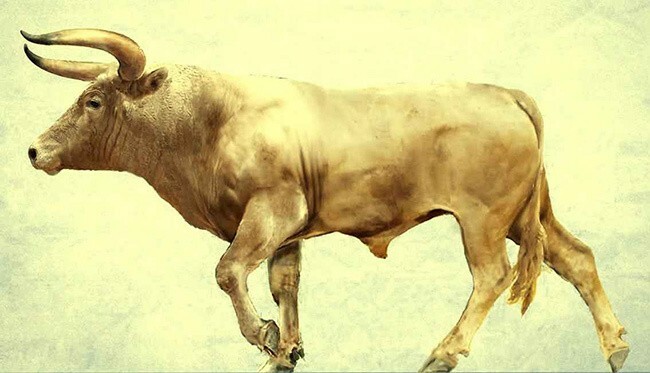
Tour , one of the most famous subspecies of the wild bull - is another representative of animals extinct due to human economic activities and hunting. The original tour was exterminated in Africa and Mesopotamia in the third millennium BC.In Central Europe, its population began to decline since the deforestation. By XV animals were taken under protection, but their numbers were steadily declining. The last tour disappeared in the middle of the XVII century. Enthusiasts from different countries are engaged in the revival of tours.
5
Black rhinoceros
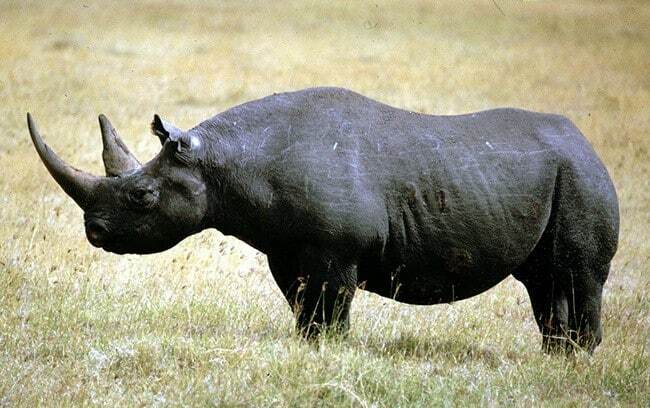
Black rhinoceros ( Cameroonian subspecies) is another representative of extinct animals due to human fault. Its name is conditional, since the color of animals depends on the color of the soil in the locality where they live. Until the middle of the XIX century, the black rhino was an ordinary inhabitant of Africa. But then, thanks to the belief in the miraculous power of the horns, hunting was opened on them. The horns of animals were also used as material for the hilts of daggers. Now the total number of black rhinos does not exceed 4 thousand individuals, but the Cameroonian subspecies did not survive the extermination by poachers and was recognized as extinct in 2011.
4
The Carolinsky parrot
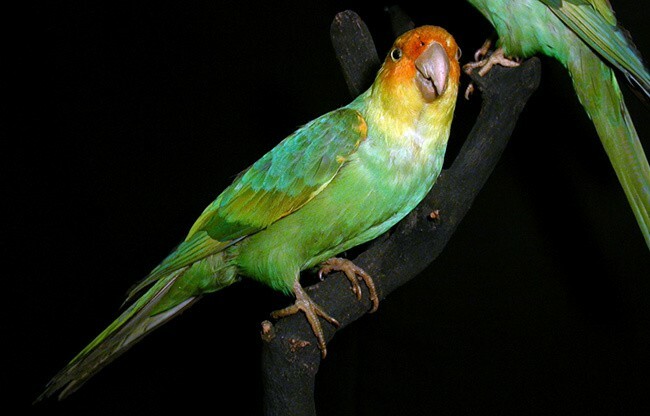
The Karolinsky parrot , the only member of the genus, became another sad example of the animals of the extinct human .He lived in North America and died as a result of merciless hunting. The last parrots of Caroline were seen in 1926.The species is officially recognized as extinct.
3
Moa

Moa - giant wingless birds, extinct by human fault in the XVI century. They lived in New Zealand. Some species had giant dimensions - up to 3.6 meters in height. Moa were herbivores. They ate fruits, leaves and shoots. They died out at the beginning of the XVI century. In the disappearance of these amazing creatures, the Majorians are guilty - the indigenous population of New Zealand.
2
The wandering dove
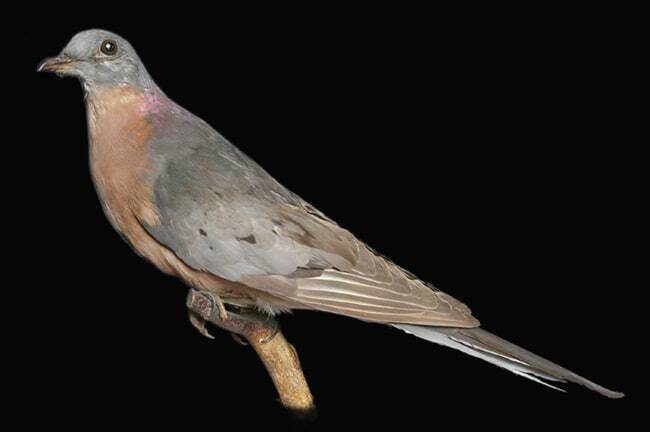
The wandering pigeon is an example of how the most common bird on Earth can be destroyed by humans. He lived in North America. The decrease in the number of populations began in the XIX century. This was facilitated by a variety of reasons, among which the first was poaching. The meat of the wandering pigeon was very tasty, and the inhabitants of the northern states mercilessly destroyed the birds. The last representatives of the species disappeared at the beginning of the XX century.
1
Abingdonian Elephant Turtle
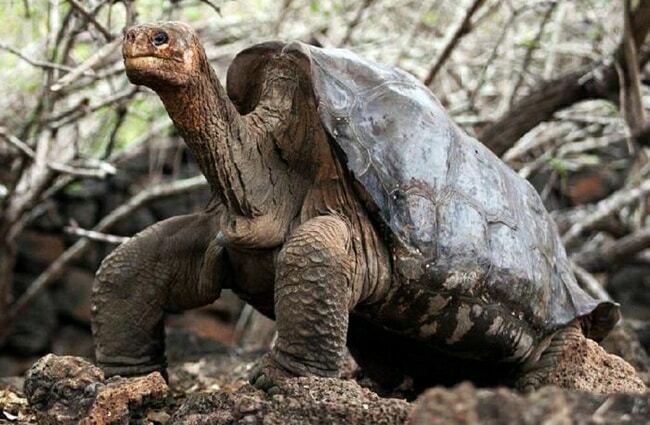
The Abingdonian Elephant Turtle is on the 1st place in the sad list of animals that have died out through human fault.
The fate of Lonely George was watched by many. He was the last representative of the subspecies of the Abingdonian elephant tortoise. The last years of his life he spent on the island of Santa Cruz, where the Darwinian Research Station is located. For many years, zoologists have not lost hope of obtaining George's offspring by crossing with related species, but the embryos of eggs proved to be unviable. June 24, 2012 the last representative of the giant Abingdonian elephant turtles died at the age of about 100 years. Now this subspecies of the Galapagos tortoises is officially recognized as extinct.
In the disappearance of elephant turtles man is guilty. For hundreds of years they have been used as live canned food, carrying ships in holds.
Statistics of endangered species of animals are appalling. Thanks to the economic activity of man every day we lose several species of animals, plants, birds and insects. We are the main cause of the catastrophic death of the animal and plant world of the Earth. Today, 40% of living creatures are on the verge of extinction and this terrible figure only increases.



